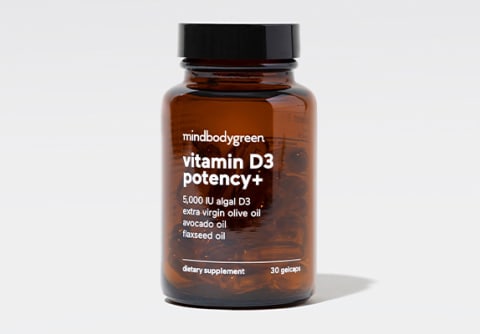Advertisement
These Are All Of The Factors That Make It Hard To Get Enough Vitamin D From The Sun


Given its nickname as the "sunshine vitamin," you'd think you could get all of the vitamin D you need from good ol' sunlight. And while your body does produce vitamin D when your skin is exposed to a specific range of the sun's UVB rays (like when you sip that iced matcha outside in the morning to start the day...and assuming it's the right time of year and you're at the right latitude), getting ample amounts of the nutrient from that golden light isn't as simple as it might seem.
In fact, several factors make it pretty darn hard to get enough vitamin D from the sun alone. Not to mention, excessive and regular unprotected sun exposure could ultimately spell more trouble for our health than it's worth.
Who might be able to get the job done with sunshine alone: "People who live closer to the equator, have lighter skin, and who get outside in [the middle of the day] when it's spring and summer," notes functional nutrition dietitian Whitney Crouch, RDN, CLT. Unless you meet all of these criteria, though, well, it's not looking good. And even then, there's the whole lifetime exposure risk thing; just ask your dermatologist.
Here's a breakdown of the different factors that can make it hard to get all of the vitamin D you need from the sun.
How we produce vitamin D.
You know how a tomato is technically a fruit? Well, in the form ultimately used in the body, vitamin D is technically a hormone, not a vitamin.
Basically, when your skin is exposed to the sun, the UV rays cause it to transform provitamin D3 (or 7-dehydrocholesterol1) into previtamin D32, which then enters circulation, where it becomes converted to 25-hydroxyvitamin D3 (in the liver), or 25(OH)D, the form of vitamin D your doctor can measure via a blood test to assess your D status situation.
From there, the kidneys and a variety of target tissues turn that 25(OH)D into 1,25-dihydroxyvitamin D3 [1,25(OH)2D], aka calcitriol3, the biologically active hormone form of vitamin D, which then performs all sorts of critical duties throughout the body, including regulating calcium and phosphorous homeostasis, promoting bone health, modulating immune function, and more.*
All in all, the process feels a teeny bit reminiscent of photosynthesis, doesn't it? (OK, it might not be a truly legit comparison but definitely reminds us how intelligent and sophisticated our bodies are, right?) And how systemically important this fat-soluble micronutrient is for our whole-body health.*
These factors make it tough to get enough vitamin D from the sun.
As magical as producing vitamin D from the sun may seem, there are a number of different variables that can affect your ability to get a meaningful amount from time spent outside:
Skin tone
Research has identified different guidelines for people with different skin tones, which outline what qualifies as the "moderate sunlight exposure5" they'd need each day to produce notable amounts of vitamin D. Based on these:
- Those with very light to light skin likely need 10 to 15 minutes of unprotected sun exposure.
- Those with naturally tan skin can get unprotected sun for 15 to 20 minutes.
- Those with darker skin can safely get one to two hours of unprotected sun exposure.
So, even if the following factors aren't issues for you, if you're not able to spend the necessary amount of time for your skin tone out in the sun each day (that's without SPF on, by the way; again, probably not what the dermatologist prescribed), then you'll fall short in the vitamin D department.
Location and time of year
Unless you live close to the equator, which receives more direct sunlight to produce vitamin D from, you'll have a hard time producing ample vitamin D throughout parts of the year. In fact, research6 suggests that if you live above or below a certain latitude (33 degrees, specifically), you'll be unable to produce vitamin D from sunlight during the winter months.
Those in Boston (which is 43 degrees North), for example, can't create the sunshine vitamin from the sun from November through February. Meanwhile, those in Edmonton, Canada (52 degrees North) are out of luck for half the year. So just "getting outside" becomes a moot point.
Time of day
To get the sunlight needed to produce vitamin D in any location during any time of year, you need to be outside with skin exposed (a decent amount, too, like your arms, legs, and midsection ideally) between the hours of 10 a.m. and 3 p.m.6 Outside of this window, the oblique angle of the sun in the sky makes its effects similar to those wintertime rays, meaning they aren't direct enough to promote significant vitamin D production.
Wearing SPF
It's no new concept that wearing SPF (ideal a natural, nontoxic mineral sunscreen) is a daily must-do. However, in doing what its name suggests, your sunblock actually blocks the very rays your skin needs in order to produce vitamin D. When used properly, a sunscreen with an SPF of 30 absorbs around 95 to 98% of solar UVB radiation6.
(That said, other research7 suggests that people don't use SPF consistently enough, or apply it generously enough, for it to offer its fully intended level of protection.) Still, though, slathering your skin in your favorite creamy 'screen can certainly stand between you and vitamin D.
Air pollution
A disturbing but true reality of modern life: The particles that make up air pollution absorb the sun's UV rays before they can reach your skin. Case in point: While most people should be able to effectively produce vitamin D in lower-latitude locations like San Diego and Los Angeles, the air pollution 6there often makes doing so more difficult.
6. How old you are
Last but certainly not least, your age can even affect the impact of the sunshine on vitamin D production. As mbg's director of scientific affairs Ashley Jordan Ferira, Ph.D., RDN, explains, "Cutaneous vitamin D synthesis from solar inputs is significantly reduced as we age, and proportionately so. Older adults and elderly folks experience a reduced capacity to produce vitamin D38 from UVB radiation, aka sunshine. That's a natural aging phenomenon, unfortunately."
To make matters worse, Ferira adds, "In addition to reduced skin D3 production, there's another deficit: The kidneys' conversion abilities, from 25(OH)D to the active 1,25(OH)2D form, also concurrently decline with age." Time is clearly not on vitamin D's side.
The bottom line.
The main takeaway here: There are a lot of factors working against the average person's ability to get all of the vitamin D they need from sunlight. Given that, the most prominent researchers and health experts in the world of vitamin D recommend taking a multifaceted approach6 to meeting your needs by striving for more sun exposure, eating foods that contain vitamin D, and supplementing with the nutrient.
Since food also fails for its own reasons (you can read more about why here), Ferira and other health experts and doctors recommend supplementing with 5,000 I.U. of vitamin D3 per day per the science, regardless of where you live, the tone of your skin, or what time of year it is, in order to achieve and maintain optimal D levels in the body.*
If you are pregnant, breastfeeding, or taking medications, consult with your doctor before starting a supplement routine. It is always optimal to consult with a health care provider when considering what supplements are right for you.
8 Sources
- https://www.ncbi.nlm.nih.gov/books/NBK278935/
- https://jamanetwork.com/journals/jamadermatology/article-abstract/548901
- https://www.ncbi.nlm.nih.gov/books/NBK56061/
- https://www.ncbi.nlm.nih.gov/books/NBK459156/
- https://www.ncbi.nlm.nih.gov/pmc/articles/PMC2290997/
- https://www.ncbi.nlm.nih.gov/pmc/articles/PMC3897598/
- https://pubmed.ncbi.nlm.nih.gov/30945275/
- https://www.ncbi.nlm.nih.gov/pmc/articles/PMC4384440/
Watch Next
Enjoy some of our favorite clips from classes
Enjoy some of our favorite clips from classes
What Is Meditation?
Mindfulness/Spirituality | Light Watkins
Box Breathing
Mindfulness/Spirituality | Gwen Dittmar
What Breathwork Can Address
Mindfulness/Spirituality | Gwen Dittmar
The 8 Limbs of Yoga - What is Asana?
Yoga | Caley Alyssa
Two Standing Postures to Open Up Tight Hips
Yoga | Caley Alyssa
How Plants Can Optimize Athletic Performance
Nutrition | Rich Roll
What to Eat Before a Workout
Nutrition | Rich Roll
How Ayurveda Helps Us Navigate Modern Life
Nutrition | Sahara Rose
Messages About Love & Relationships
Love & Relationships | Esther Perel
Love Languages
Love & Relationships | Esther Perel


















